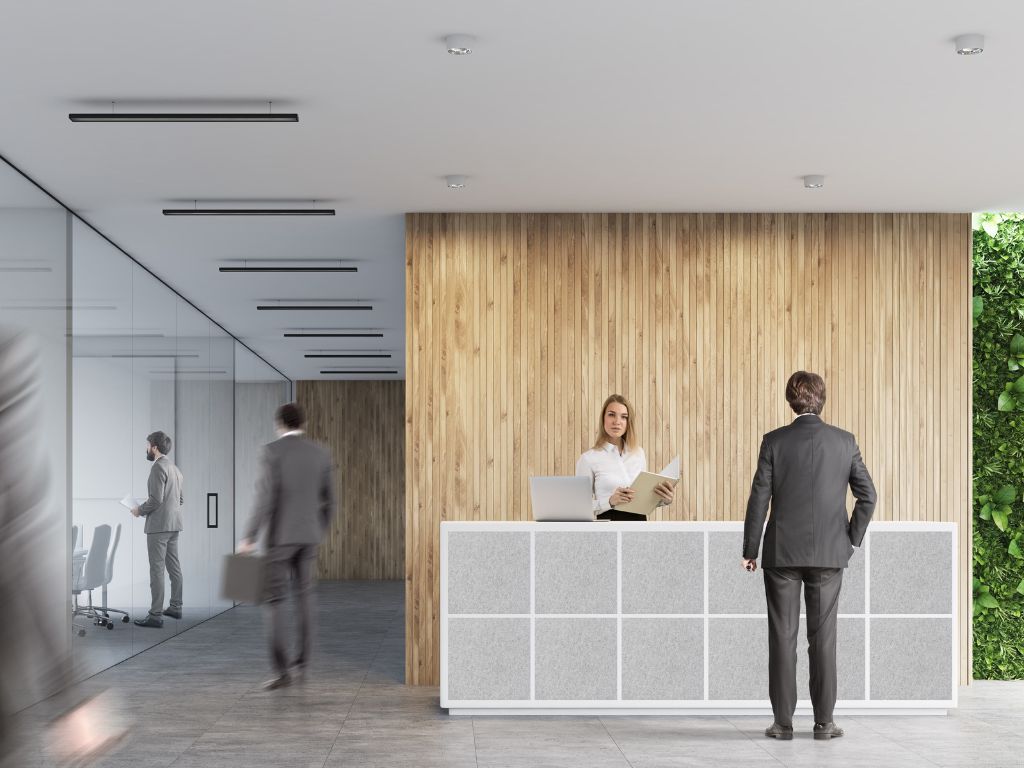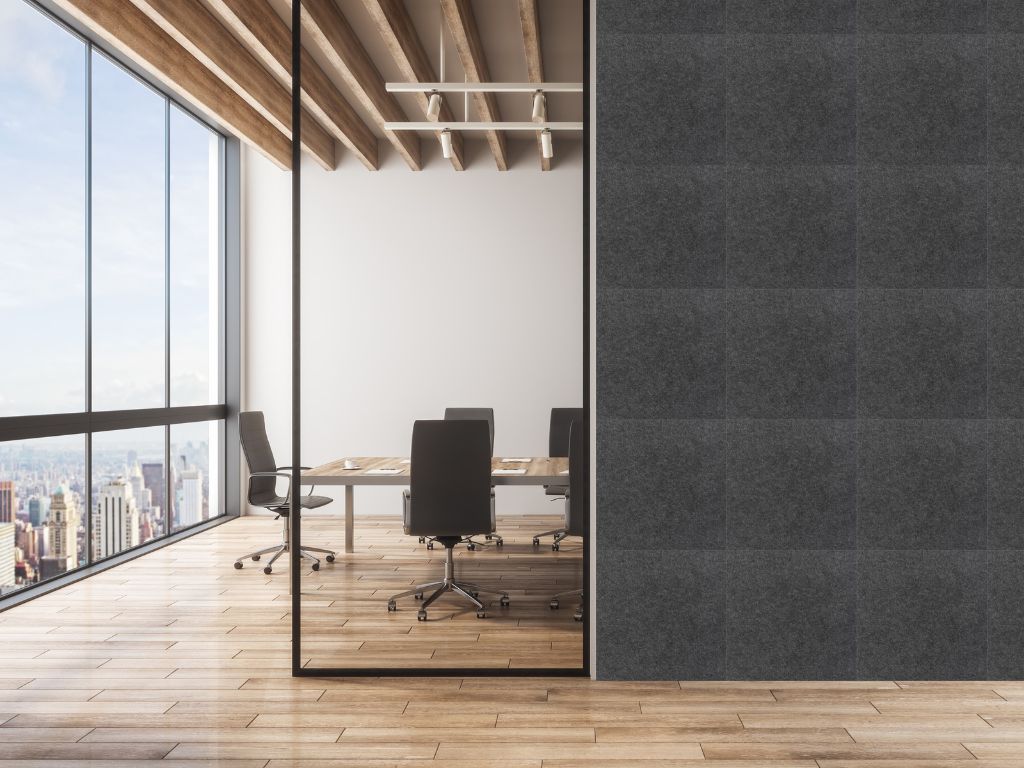What are Acoustic Panels: Definition, Benefits & Facts
Overview
Acoustic panels are sound-absorbing panels used to absorb noise, reduce reverberation and improve the overall acoustics of an indoor space. They are made from acoustic foam, recycled PET, acoustic fabric, wool or other types of porous sound absorbing materials. They can be frameless or contained by timber frames.
Acoustic panels can have a significant impact on the acoustics of an indoor space, helping create quieter rooms, rooms with better acoustics and more peaceful, private and calming interior spaces overall. People who use spaces with improved acoustics generally experience improved well being, less stress and improved learning outcomes, efficiency and productivity.
What are the benefits of acoustic panels?
What are acoustic panels made of?
What are acoustic panels?
Acoustic panels, also known as soundproof panels, are sound-absorbing panels that are placed on walls and ceilings of interior spaces to improve its acoustics by reducing noise, reverberation and echoes.
They do this by absorbing excess acoustic waves, which cuts down on the echoes and reverberations that can make rooms noisy.
They can also spread sound more evenly around a room. These panels are ‘diffusers’ and are usually used in conjunction with absorbers to achieve good acoustic balance.
Also referred to as sound panels, acoustic baffles, or acoustic boards, they are a solution for offices, classrooms, and conference spaces so that people can hear each other clearly.
What are acoustic wall panels for?
Acoustic panels have the following functions:
Absorb or dampen background noise
Reduce echo and reverb
Improve sound quality inside the room
Buffer noise pollution
Clarify speech
Dampen or deaden soundwaves
Keep noise in
Indirectly, reduce stress and increase productivity

What are the benefits of acoustic panels?
Acoustic panels, acoustic wall tiles or horizontal acoustic panels are important if you want to eradicate unwanted noise and sound reflection. There are several reasons why they can be a good investment in multiple spaces:
- create a peaceful and calming interior atmosphere
- quieter rooms
- improved well-being
- acoustic privacy
- increase productivity
Sound panels can create a peaceful, calming interior atmosphere.
Acoustically balanced rooms can create an ambiance that makes everyone feel comfortable and safe as they walk into a space.
Large, busy, shared places like hotel and office lobbies benefit from this type of acoustic paneling.
The customer or client is ushered into a cool, calm reception and immediately feels ‘good energy’ about the place.

Quieter rooms mean less stress
A recent study in the Journal of Management and Organisation shows that noise can be a major stressor in the workplace. Acoustic panels can provide significant relief from the contemporary reality of workflow noise generation. Quieter spaces will decrease anxiety, improve concentration and add to productivity.
Acoustic panels are specifically designed to diminish background noises, reverberations, and echoes. Crafted for sound absorption, they can lessen the noise intensity of busy spaces.
Improved well-being
Prolonged exposure to loud noises can lead to long-term stress and even hypertension, as the Australian Academy of Science reports. As such, healthcare spaces need targeted noise management. Patients and staff need a restful atmosphere, which is particularly important to heal and provide care.
Large open offices can also have noise levels of 50 to 70 decibels or more, a level which can activate stress responses, including fight or flight.
Acoustic Privacy
Acoustic panels can increase privacy in the workspace. In an open-planned environment, background noise is unavoidable and can be overwhelming.
Panels can increase privacy for personal conversations, confidential video conferencing, and phone calls. They can absorb intruding background noise and voices, giving a sense of cocooned meetings and a private workspace.
Good acoustics can increase productivity
Background noise can disrupt thought processes and break up workflow. This ultimately affects how efficiently a person can work and concentrate.
Do acoustic panels work?
Yes, acoustic panels provide a significant reduction in noise, in most cases.
Panels can help to dampen noise coming from within from spreading internally by buffering walls and ceilings.
Ideally, buildings are constructed to keep outside noise to a minimum.
However, for many reasons, such as poor materials, room size, and the layout of internal space, noise can become a significant problem.
They work well as being cost-effective for retrofitting buildings and improving users’ comfort. Wall acoustic panels can enhance the comfort and function of every space.
How do acoustic panels work?
Sound panels improve rooms through sound-wave absorption. They resist and reflect as well as stop echoes and background noises.
Do acoustic panels block outside noise?
Acoustic panels will not block outside noise completely, but can help to absorb and reduce noise within a room.
Do panels keep sound out?
Sound panels are effective for reducing noise inside a room, however they do not block outside noise from coming in. Instead they absorb and dampen internal sound.
If sound is already occurring inside a room, panels stop and dampen it from reverberating around the room. However, panels cannot stop noise coming from the outside in.
Will acoustic panels keep sound in?
Acoustic panels cannot ensure inside noise will be kept inside.
They are designed to absorb noise that occurs inside, but cannot completely stop it dead from exiting a room.
Do soundproof panels work both ways?
Soundproof panels usually don’t work both ways. For that to happen the shape of the foam needs to be uniform on both sides, and be of equal thickness and coverage on both sides.
A complete barrier is needed between the inside and outside of a room for this to work properly.
Do acoustic panels reduce noise?
Panels reduce noise according to their NRC (Noise reduction coefficient) which defines how much quieter a product can make your space.
The noise reduction coefficient is a number value ranging from 0.0 to 1.0 that describes sound absorption performance. The closer to 1, the better they perform.
Our panels have a 0.75 NRC, making them really good for mitigating reverberation, noise, or talking in busy interior spaces.
Acoustic Panels vs Soundproofing
Acoustic panels absorb sound and echo within a room meanwhile soundproofing products will block or stop sound transmission from entering a room.
Panels can be placed strategically to control echo and reverberation in a room, whereas soundproofing prevents from entering or exiting a room.
Here is a comparative look:
Acoustic panels:
- Are meant to control echoes and reverberation in existing rooms.
- Can be placed at any point in the lifetime of the space
- Can be positioned at various points in a room and are the most appropriate system for controlling sound in day-to-day situations.
- Work to soak up, reinforce or disperse soundwaves as required.
- Can reduce noise between rooms by damping noise within the space that could go to another room.
Soundproofing:
- Ensures noise or sound cannot come in or out of the room.
- Placed during the construction phase of the building or room.
- Places thick and dense materials in constructing walls, doors, and windows.
- Utilises ‘damping’ techniques, where walls and floors are ‘floated’ from the overall structure of the building, and shock mounts are hung from ceilings.
Can acoustic panels soundproof a room?
Acoustic panels can’t completely soundproof a room but they are ideal to enhance clarity of listening and speaking in classrooms, offices, cafes and event spaces.
What are acoustic panels made of?
Most acoustic panels are made from recycled PET or a timber frame covered by layers of foam and acoustic fabric on top, however acoustic panels can be made of any of the following materials:
- Acoustic foam
- recycled PET
- Mineral Wool
- Acoustic fabric and fibres
- Felt
- Glass wool
- Timber or wood frames
The foam is fire-resistant high-density, which means greater resistance to and absorption of echoes, conversation and other noise. They are made from mineral wool or shaped foam and a poly-blend or natural fabric to cover the fill material.
The acoustic fabric is a breathable, fine mesh, that is customised to match the space’s décor.
Where to place acoustic panels for best sound absorption?
For the best sound absorption acoustic panels should be put on hard surfaces like walls and ceilings, at ear level and on reflexion points first.
Ultimately, the acoustic panel placement for best sound absorption will depend on:
- Floor-type
- The number of windows
- Ceiling height
- Number of people occupying the space
If noise comes from a single source, making sure sound panels are placed opposite to that source where the sound waves travel would be helpful.
If noise sources are spread out throughout the space then covering as many hard walls as possible will create the best results.
Learn where to place acoustic panels

How many Acoustic Panels Will I Need?
For a noticeable difference to a room’s sound quality, panel coverage should be at least 15-30 % of the surface area. The exact number of panels needed will depend on the size of your wall/room, the NRC of the panels and the amount of noise control needed.
For small spaces, a typical starting order is 8-10 acoustic panels with an NRC value of 0.75, but this number can go up to 20-25 panels in bigger spaces.
For example, for a busy office space, it is recommended that a wall is covered by 30% to notice a difference in sound quality. Panels can be strategically placed when the echo or sound resonance of a room is too strong.
Keep in mind there is no definitive answer as to how many panels you should install as every room has a different size and need. If you need professional guidance how to install acoustic panels get in contact with us to find out how you can best fit out your space.
Acoustic Wall Panels
Acoustic wall panels are an effective solution for improving the acoustics of a room while adding a decorative touch. Specifically designed to absorb sound waves, reducing echoes and reverberations within a space, acoustic panels can be installed on both walls and ceilings, offering versatility in their placement.

Key takeaways
Acoustic panels are sound-absorbing panels used to absorb ambient noise and reduce reverberation and echo in interior spaces.
Acoustic Panels make environments more comfortable and productive.
Even one fully covered acoustic panel wall will make a difference, but aim to cover at least 15-30% of the total hard surface area for a noticeable difference.
Acoustic panels should be placed on the hard surfaces within a room. The best placement will depend on the source of noise, floor-type, ceiling height and window placement.
Acoustic panels reduce noise within a space, but are not meant to keep outside noise from coming in a space.
Soundproofing keeps outside noise from coming in a space, but doesn’t reduce the noise generated within the room.
Acoustic panels can be designed and arranged to suit the needs and design of any room.







